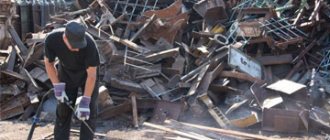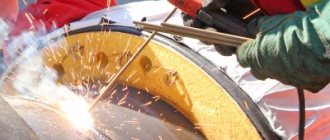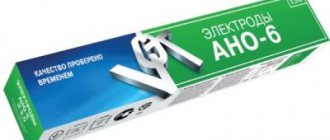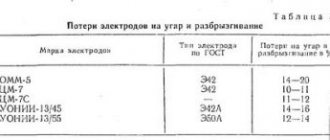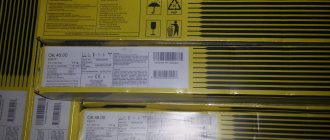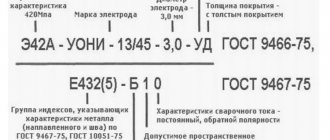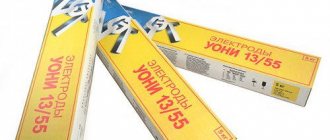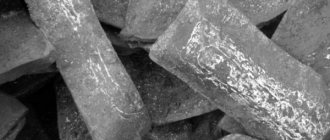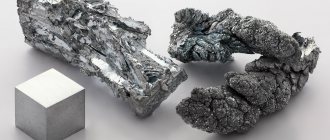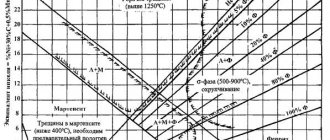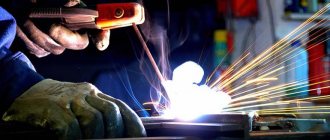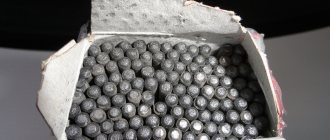Attachments: from 1,930,000 rubles
Payback : from 8 months
The construction sector and everything connected with it is considered the most promising for business. There is a constant demand for such materials. For example, for electrodes that are necessary for welding work. Their production is technologically simple and does not require large financial investments. No special licenses or permits are required for implementation. Products can be certified on a voluntary basis. How to succeed in this business and what is needed to produce this material, you will learn from this article.
Rod production
For the manufacture of electrodes, welding wire made of low-carbon, carbon, alloy or high-alloy steel is used. It is necessary to select a material based on the properties of the metal structure being welded.
The production of rods occurs using straightening and cutting machines, on which:
- a wire of the required diameter is bent and then straightened;
- the straightened wire is divided into rods of the required length.
Then the machine operator checks the workpieces and sorts out the defective products.
Manufacturing of electrodes by crimping method
But the coating method used at home is not suitable for the manufacture of electrodes on an industrial scale. It is unlikely that large companies in need of large quantities of welding material will buy “handicraft” products without a certificate and accompanying documentation, even if they are of good quality.
Therefore, in an enterprise that has plans for further development and expansion, it is preferable to use electrode production technology using the crimping method. Since the product obtained in this way maximally complies with modern requirements and standards for welding materials.
Crimping is the production of welding electrodes using special presses, where they are exposed to high pressure (from 300 to 650 kgf/sq. cm). The process consists of pulling a metal workpiece (electrode wire) through the holes located in the installation cylinder, which is filled with a coating solution.
Finished products are checked for defects and the ends are cleaned. Only after this are the electrodes labeled and packaged. The waste remaining after the operation of the scrap cleaning machine is sent for processing and then put into production of the next batch of products.
To organize a mini workshop, you need a line for the production of medium-power electrodes, including:
- rod feeder;
- GEP – hydraulic electrocoating press;
- stripping installation.
Additional devices:
- MPE – electrode supply mechanism;
- MZT – stripping and transportation mechanism;
- Ballast – automatic straightening and chipper, equipped with a receiving hopper and a wire unwinder;
- BP – briquette press;
- MOB (10) – a mechanism for cleaning raw defective electrodes;
- MS (50) – wet mixer.
The price of equipment for electrodes varies from 6,800,000 to 8,000,000 rubles.
It should be noted that the coating is a necessary component of the electrode, facilitating uniform melting of the metals being welded. And the slag crust formed during the welding process blocks the access of oxygen to the connecting seam, which avoids rapid loss of temperature on the surfaces being welded. The result is a perfectly smooth seam, without bubbles and microcracks.
More to read:
What kind of machine should I buy for the production of masonry mesh?
How to open a plant for the production of fiberglass reinforcement?
We are opening our own production of profile pipes.
Creating a Coverage
Coating is necessary to protect the weld pool from oxygen, which can have a negative effect on the metal structure. The composition of the coating is affected by the type of electrode. During production, the coating is checked for the presence of main components and impurities.
The coating is prepared according to the following scheme:
- materials are divided into medium and large sized elements;
- They are crushed using disintegrators and ball mills;
- the elements are sifted through a sieve;
- Ferroalloy particles are passivated by aging in air or heat treatment - in the process, a film is formed around the elements, which does not allow the reaction with liquid glass to start;
- materials are dosed in the required proportion and mixed until a homogeneous mass is obtained;
- The binder is prepared and added to the dry mixture.
The result is a thick coating.
Risks
The electrode manufacturing business can become successful. It will develop if the business is properly organized and an advertising campaign is carried out. To do this, you need to distribute advertisements in the media and on the Internet. You can distribute leaflets or try to contact direct suppliers. It must be taken into account that business depends on seasonality. Peak sales occur between March and November. Make sure you have enough finished products. In winter there is a decline. Taking this factor into account, it is necessary to plan the launch of the production workshop.
Applying coating
When performing this stage, presses are used to create the necessary pressure. Application proceeds as follows:
- briquetting of coating mass;
- seal with a special piston;
- the rods are directed into the coating head, where at the same time the coating mass is supplied;
- they pass together through the hole of the calibrating sleeve located in the coating head.
By following a clear algorithm of actions, it is possible to obtain a uniform coating of the rods. The main thing is to install the calibrating sleeve correctly. It is with its help that you can obtain the desired thickness of the coating, which affects the quality of the weld. If the layer is too thick, the coating will crack during calcination work.
Electrode feeding mechanism
Category: Equipment for the production of welding electrodes
The electrode feeding mechanism is designed to feed rods 350-450 mm long and wire with a diameter of 3.4.5 mm into the head of the electrode coating press. The electrode feeding mechanism consists of a cabinet with an electric motor installed inside, a drive box for feed rollers and a hopper for rods. Turning on the rotation of the electric motor, the “Start” and “Stop” buttons are displayed on the control panel of the electrodecoating press. Speed adjustment is smooth, stepless.
Read more
Drying and calcination
The next stage of how electrodes are made is drying. It can occur directly after crimping in special ovens. It is performed if rutile coating is used, where temperatures up to +200°C are required.
If the main coating is selected, then the products first go into drying racks, where they remain for several hours at a temperature of +30°C. After this, they are sent to a heating furnace, where they are heated to +400°C.
After calcination, products are selected for testing, and the electrodes are accepted and packaged. They are packaged and stored.
Electrode factories and welding electrode manufacturers
Electrode factories are enterprises that produce welding electrodes - metal or non-metallic rods made from electrically conductive materials that provide current supply to the product being welded. The electrode industry, which is a sub-sector of non-ferrous metallurgy, influences the level of development and quality of products in:
- production of the entire range of steels;
- production of aluminum, magnesium, titanium;
- material supply for nuclear and space technologies;
- development of new technologies for the production of sorption materials and information systems.
Currently, more than 200 different brands of electrodes are produced. Carbon materials (natural and artificial) with a high carbon content (about 90%) are used as raw materials for their production.
Classification of products from electrode factories is carried out according to the following criteria:
- material used for the manufacture of electrodes (non-metallic (graphite, carbon), metal: non-consumable (nitrated, tungsten, lanthanum, thoriated), consumable (steel, bronze, cast iron, aluminum, copper, etc.);
- purpose for welding certain types of steels (for welding carbon and low-alloy structural steels, alloyed structural steels, heat-resistant alloy steels, high-alloy steels with special properties, for surfacing a surface layer with special properties);
- the thickness of the coating applied to the rod (with thin, medium, thick and extra thick coating);
- types of coating (with acidic, basic, cellulose, rutile coatings, mixed-type coatings, with other types of coatings);
- the nature of the slag that is formed during the melting of the coating;
- technical characteristics of the weld metal;
- permissible spatial positions of surfacing or welding (for welding in any positions, for welding in any positions, excluding vertical (top to bottom), for welding in the lower and horizontal positions on a vertical plane, for welding in the lower and lower boat positions);
- the type and polarity of the current used in welding.
Electrode production consists of the following technological processes and operations:
1. Washing of lump materials: lump materials and silicate blocks are cleaned of waste rock and contaminants in washing machines.
2. Crushing lump materials in crushers.
3. Drying of electrode materials in drying units.
4. Grinding of electrode materials using ball mills.
5. Passivation of active ferroalloys in autoclaves, carried out during the melting of liquid glass.
6. Preparation of liquid glass used as a binder in the manufacture of coating mixture.
7. Production of charge, coating mass, carried out by:
- dosage of components according to the recipe (carried out using an automatic dosing unit);
- mixing dry ingredients (produced in mixers);
- preparing the coating mass (the so-called wet mixture) in countercurrent or runner mixers;
- preparation of briquettes on briquetting presses.
8. Production of electrode rods by straightening and cutting wire on straightening and cutting machines.
9. Crimping of electrodes on an electrode-making press, performing:
- feeding the coating mixture into the cylinder and press head;
- feeding the rods into the press head, crimping them with coating;
- supply of electrodes for stripping ends to the stripping unit;
- supply of electrodes along a conveyor for drying in a drying and calcination oven.
- The priority for the discovery of welding technologies belongs to Russia: in 1802, Professor V.V. Petrov was the first to use electrodes, experimentally studying the properties of an electric arc. In 1882, Russian inventor N.N. Benardos proposed using a burning electric arc between a carbon electrode and a metal piece to join the metal edges. A patent for the invention of welding technology using coated consumable electrodes was received in 1906 by the Swedish scientist O. Kjellberg.
Control at production stages
In the manufacture of electrodes, every stage from the production of rods to storage is important, since strict adherence to all steps affects the quality of the weld and the reliability of the structure. To ensure proper product quality, Magnitogorsk Electrode Plant (MEZ):
- uses high-quality equipment at all stages of production;
- uses materials that comply with standards;
- carries out quality checks during product manufacturing;
- tests finished products, which helps to avoid defects.
As a result, this makes it possible to obtain reliable welding electrodes. Their quality is confirmed by the availability of appropriate certificates.
What is needed for implementation?
A small workshop can be opened even in a room of 30 square meters. m. The selected building must meet certain requirements:
- availability of three-phase power supply;
- area for storing finished products and raw materials;
- high-quality ventilation system.
To produce electrodes you will need:
- crushing plant;
- coating press;
- cutting machine;
- marking machine;
- mixer for raw materials;
- drying oven;
- stripping machine;
- Packaging equipment.
Production can be organized without the use of expensive equipment. In this case, more human resources and careful product quality control will be required.
During the technological process, the steel wire is cut into pieces of 30-40 cm. The resulting pieces are protected and straightened.
The raw materials must be of high quality in order to obtain a high grade and class of electrodes. When searching for suppliers, you should consider their reputation. For production you will need wire, chalk with additives, and a potassium block.
It is necessary to carefully select staff. The quality of the product will depend on them. A solo venture will require more manual labor. Only a few people are needed there.
A mini-workshop, where there is special equipment, will need repairmen, installers, technologists, and operators.
